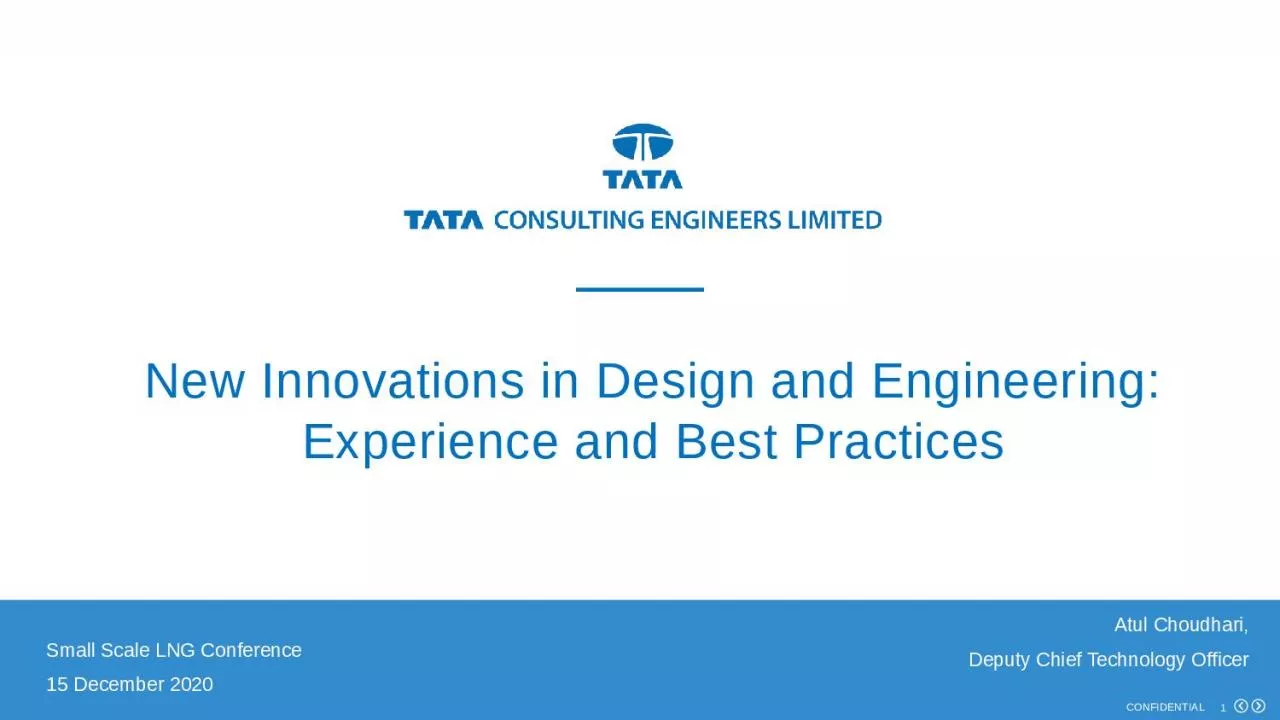

New Innovations in Design and Engineering Experience and Best Practices Small Scale LNG Conference 15 December 2020 From Large Scale to Small Scale LNG Source International Gas Union IGU LNG as marine fuel ID: 1030786
Download Presentation The PPT/PDF document "Atul Choudhari, Deputy Chief Technology..." is the property of its rightful owner. Permission is granted to download and print the materials on this web site for personal, non-commercial use only, and to display it on your personal computer provided you do not modify the materials and that you retain all copyright notices contained in the materials. By downloading content from our website, you accept the terms of this agreement.
1. Atul Choudhari, Deputy Chief Technology Officer New Innovations in Design and Engineering: Experience and Best PracticesSmall Scale LNG Conference 15 December 2020
2. From Large Scale to Small Scale LNG Source: International Gas Union (IGU)LNG as marine fuelClean Fuel – LNG demand in automotive sectorPower generation for remote areasLack of sufficient domestic gas production, import terminals, natural gas pipeline infrastructure.At present, 16800 km long Natural Gas pipeline network is operational.It has been envisaged to develop additional about 14,300 km pipelines to complete the National Gas Grid and same are at various stages of development.
3. Emerging Trends – Terminal ConfigurationCost Optimization in Design of Small Scale TerminalUNLOADINGUnloading : Jetty Infrastructure, Unloading Arms, Pipelines.STORAGEStorage Tanks, BOG Management.SEND OUTVaporization, Metering and Send Out- Pipelines, Trucks.UNLOADINGSTORAGESEND OUTSmall Scale Vs Large Scale Terminal
4. Optimization OpportunitiesAProcess OptimizationB Technology SelectionCTerminal CapacityDLayout, Operations OptimizationProcess OptimizationCancellation Of EquipmentVapor Return ArmVapor Return BlowerBOG Re-condenserHP PumpTechnology Selection Storage Capcity FinalizationTank Type Selection based on Risk AssessmentBOG HandellingVaporizer Type SelectionTerminal CapacityShip sizeSend out RateLayout OptimizationLower InventoryCompact DesignLocation Selection
5. Optimized Small Scale TerminalPower PlantAbsorber LNG Storage TankLNG CarrierLNG Unloading ArmAmbient Vaporizer BOG Compressor DrumBOG CompressorTruck Loading
6. Everything Must be ChallengedReducing Capital Costs of ProjectsStarting from codes and standards to the way things are built-for example, the use of expensive pipe racks; the optimum use of proper materials; and even sparing philosophy, reliability and availability.Unlike the custom, stick built, large-capacity storage tanks for mega-size LNG projects, the small-scale facilities can use prefabricated tanks or pressurized storage. New technologies, such as pressurized storage tanks, are available off-the-shelf in increments of 1,000 m3, which are suitable for small-scale LNG.Formation of alliances and partnershipsRisk-sharing from “cradle to grave”Addition of modular capacity as needed or as justifiedNext-generation modularization to reduce cost and scheduleStandardization of designMinimization of cost on high-cost itemsMinimization of time to marketUse of prefabricated equipment like tanks and compressors, rather than custom-designed, field-fabricated equipment. Significant advances have been made to reduce construction costs with the next generation of modularization. The new techniques being developed lower construction costs by 30% and reduce schedule by 25%, resulting in quick payout and cost savings.
7. New Regassification TechnologyPrinted Circuit Heat ExchangersCompact Construction – Space SavingsModular Construction – Time SavingSecondary Heat Circuits – No Exotic MOCs for Handling sea waterEase of Operation and Maintenance
8. New Pool Fire Suppression TechnologyReduce LNG Pool Fire RisksFOAMGLAS® PFS™ Generation 2 pool fire suppression system complements safety programs by delivering a reliable, low-maintenance passive solution for the reduction of thermal radiation and flame height in contained LNG fires.Contains specially formulated low-density cellular glass that has a combination of physical properties not found in traditional fire suppressant foams. The material is both extremely buoyant and nonflammable.Works in conjunction with fire fighting foamsQuickly limiting thermal radiation and flame height- Highly buoyant - Rises immediately to the surface of the LNG- Provides an insulating cap that can aid in reducing vaporization- A passive system that remains in place- Provides immediate and automatic control of LNG pool fires -No deployment delay
9. New Insulation TechnologyInsulation Jackets for Complex shaped Valves Quick And Easy Installation:Insulation Jackets are Flexible and designed to fits snuggly – Installation time is significantly lower than conventional options.Prevent Waste and Excess Cost of Hard InsulationWith a removable insulation blanket, you can remove the insulation whenever necessary, then easily reinstall it yourself!Extend the Life of Equipment & MachineryProtect expensive equipment by reducing exposure to the elements and shielding it from accidental damage.Improve Workplace SafetyRemovable insulation covers can prevent direct contact with high-temperature pipes and equipment for greater workplace safety.Example - Thermaxx Cryogel Z by Aspen Aerogels – Extreme low thermal conductivity.
10. Membrane TechnologyEmerging Alternative to Conventional Containment tanks
11. Safety Aspects- LNGLNG is Non toxic, Non carcinogenic, 5%-15% flammability rangeLNG Spills: primary hazard of the flammable LNG is the possibility of a fireVapour Dispersion: Vapor cloud ignitionThermal Radiation: radiant heat from the flame which could cause personal injury, property damage and potentially secondary firesEnvironmental Impacts: GHG emissionsActs of Nature (storm, earthquake etc)External Fire: Storage tanks would be protected by the impoundment dike, which would serve as a firebreak around the tank and process area. Furthermore, the facility shall be equipped with an extensive firefighting system, which can be used to protect the facility from an external fire.A major release would be contained within the dike or sump and thermal radiation is predictable and part of the risk assessment process. A vapour release that ignited would burn until the fuel was consumed or the fire extinguished. In either case, the fire and thermal radiation would be contained within the facility boundaries, minimizing the danger to the surrounding areaRoll Over PhenomenonLeak Containment
12. Emerging Trends in S- LNGNew Value ChainDevelopment of LNG truckingDevelopment of L-CNG HubsHydrogen Enriched H- CNGFSRU – Quicker Option?CGD InfrastructureDigital Technologies
13. Asset Information ModellingLogistics: Improve Schedules, Enhance Safety, AI- Predictive AnalyticsIndividual AssetUnstructured DataScan PDF to 2D(Digital Handover)Engineering Drawings and P & IDFinal Validated Drawings and DocumentsInterlinking of all the documents with 3D ModelModel Centric AIM
14. Atul Choudhari – Deputy Chief Technology officer9820048904achoudhari@tce.co.in